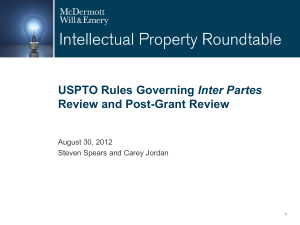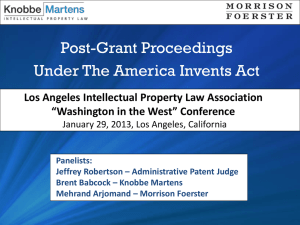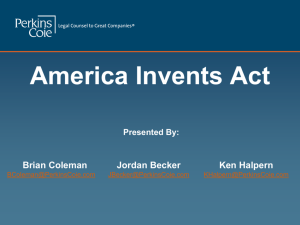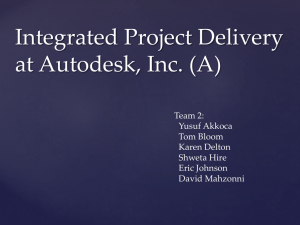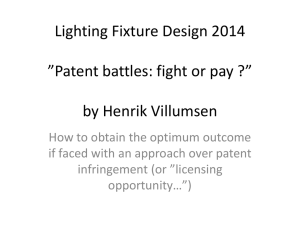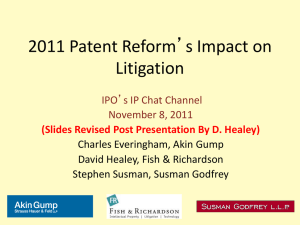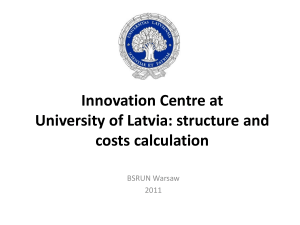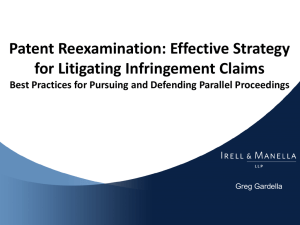Inter Partes - Association of Corporate Counsel
advertisement
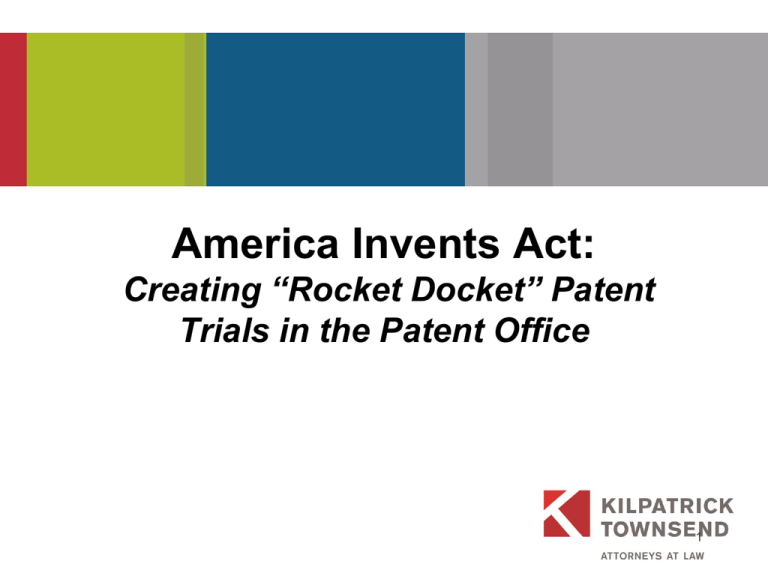
PRESENTATION TITLE America Invents Act: Creating “Rocket Docket” Patent Trials in the Patent Office 1 Agenda Overview of the old and new tools New tools – Timing – Strategic considerations – Costs Case studies exploring effectiveness of the new tools Status of Rules Governing Procedures 2 Pre-9/16/12 PTO Tools Ex Parte Reexamination Inter Partes Reexamination Patents/printed publications Patents/printed publications Substantial new question Reasonable likelihood of prevailing No discovery, no oral hearing No discovery, no oral hearing No estoppel Estoppel (PTO and D/C) No settlement effect No settlement effect Patent owner may request 3 Post-9/16/12 PTO Tools Ex Parte Reexamination Inter Partes Reexamination Post Grant Review Patents/printed publications Patents/printed publications Any invalidity ground Substantial new question Reasonable likelihood requester prevails More likely than not 1+ claim unpatentable; and/or novel/unsettled legal question No discovery, oral hearing Discovery, oral hearing Discovery, oral hearing No estoppel Estoppel (PTO, D/C and ITC) Estoppel (PTO, D/C and ITC) No settlement effect Settlement terminates, no estoppel Settlement terminates, no estoppel Patent owner may request Available 9/16/12, if no PGR Patents filed after 3/16/13 Within 12 months of litigation Within 9 months of issuance 4 Summary of Major Areas of Change Proceeding Purpose & Timing Issues & Prior Art Strategic Considerations 3rd Party challenge of patent within 9 Post-Grant months of issuance Review Any ground of invalidity (§§ 101, 102, 103, 112, 251) – not limited to patents or printed publications Balancing Litigation Defenses with Estoppel Provisions 3rd Party challenge of patent after PGR Inter Partes window or conclusion Review of PGR* Limited to novelty, obviousness (§§ 102, 103) – limited to patents and printed publications Balancing Litigation Defenses with Estoppel Provisions * PGR only available for patents filed on or after 3/16/2013. Practically, PGR will not be implemented until approximately 2015. 5 Timing 6 PGR Challenger’s prior DJ lawsuit forfeits review entirely Patent app. filed after 3/16/13 Patent issues (likely 2015 or later) “Raised or reasonably could have raised” Patent expires Estoppel 9 mos. 2 years Request for PGR filed PGR completed Invalidity based on: • Patents • Printed publications • Prior use/sale • Insufficient disclosure • Etc. 7 IPR: Scenario A (no PGR, no lawsuit) Challenger’s prior DJ lawsuit forfeits review entirely Patent issues “Raised or reasonably could have raised” Patent expires Estoppel 9 mos. 2 years No PGR filed IPR Filed IPR Completed Invalidity based on: • Patents • Printed publications • Double patenting 8 IPR: Scenario B (lawsuit) “Raised or reasonably could have raised” Patent issues Patent expires Estoppel No PGR filed, > 9 mos. elapsed 1 year 2 years Patentee lawsuit IPR must be filed within 1 year IPR Completed Invalidity based on: • Patents • Printed publications • Double patenting 9 USPTO Proposed Timeline for Conducting PGR and IPR Petition Filed PO Preliminary Response 2 months Decision on Petition 3 months PO Petitioner Reply Response & to PO Motion to Response & PO Reply to Amend Opposition to Opposition to Claims Amendment Amendment 4 months PO Discovery Period Oral Hearing 2 months 1 month Hearing Set on Request Petitioner Discovery Period PO Discovery Period Period for Observations & Motions to Exclude Evidence Final Written Decision No more than 12 months Proposed Trial Practice Guide: Federal Register 77(27):6868, 09-Feb-2012 10 Procedures – “Rocket Docket” Patent Office Trials Sample Scheduling Order • 4 months for PO response to petition and amendment proposal, • 2 months for Petitioner reply, • 1 month for PO reply to Petitioner’s opposition, • 2-3 months for motions to exclude evidence and oral hearing, and • 2 months for final written decision. 11 Strategic Considerations 12 Maximizing Options Proactive Approach Patent Monitoring Freedom to Operate Analysis Other Opportunities Post-Grant Challenge • Notice letter from patentee • Stalled prelitigation negotiations • Prior art search reveals new invalidating art • Litigation filed • License expiration 13 Benefits to Challenger Cancellation of claims - Avoid infringement - Freedom to operate Amendment of claims - Intervening rights Patentee admissions Prosecution history estoppel Create intrinsic evidence 14 Strategic Pros And Cons Pros Ex Parte Reexam Cons • Faster/less expensive than litigation • Only patents/printed publications • No estoppel • No involvement after request • Anonymity • $17,760 Filing fee • Multiple reexams • Lower burden of proof • Technically sophisticated 15 Strategic Pros And Cons Pros Inter Partes Review • Less expensive than litigation Cons • Only patents/printed publications • Discovery, oral hearing • Some invalidity grounds remain for litigation • Lower burden of proof • Estoppel on patents and printed publications that could have been raised • Effectively prevents ex parte reexam • Technically sophisticated 16 16 Strategic Pros And Cons Pros Post Grant Review • Less expensive than litigation • Discovery, oral hearing • Lower burden of proof Cons • Estoppel on all invalidity grounds that could have been raised • Effectively prevents IPR and ex parte reexam • Technically sophisticated • Broad invalidity bases 17 Estoppel - Inter Partes Review Parallel Litigation PTO Determines Patent Valid Parallel Litigation District Court Holds Patent Valid When Estoppel Attaches Inter Partes Reexam Estopped from validity defense (raised or could have raised in Inter Partes Reexam). •District Court Only Inter Partes Reexam Vacated -Estopped Final Decision Appeals Exhausted Inter Partes Review Estopped from validity defense (raised or reasonably could have raised) •ITC & District Court No Estoppel* (PTAB) Written Decision * Practical Estoppel for Inter Partes Review filed by party more than one year after being sued for patent infringement. §315(b). 18 Strategic Timing: Inter Partes Reexam v. IPR Inter Partes Reexam (pre-9/16/12) IPR (post-9/16/12) Standard: reasonable likelihood of prevailing Standard: reasonable likelihood of prevailing (but effectively may be higher to ease burden on PTAB) If not converted to IPR procedure, longer time to decision, estoppel Faster time to decision, estoppel Can file even if already in DJ litigation or litigation > 1 year Cannot file if DJ litigation before IPR; cannot file if in litigation > 1 year Long delay often a factor in denying Unknown impact of shorter time to stay motions decision – more inclined to stay? Greater ability of PO to amend More restricted amendments 19 Strategic Issues: PTO vs. Litigation Factors Post-Grant Review Burden of Proof Preponderance of Evidence Clear and Convincing Evidence Presumption of Validity No Yes Claim scope Broadest reasonable interpretation (Suitco) Contextual (narrow) construction (Phillips) Complexity and nature of attack Any basis other than best mode • Any references, but limited to best • Any basis but best mode Decision maker Inter Partes Review References limited to printed publications, but must pick best PTAB 3 Judge Panel Litigation Average Juror 20 Practical Considerations and the Governing Rules 21 Procedures – “Rocket Docket” Patent Office Trials • Goal to improve timing over Inter Partes Reexaminations. – May increase likelihood of automatic stay “sticking.” Projected Timing Inter Partes Reexam 5+ years to BPAI decision Inter Partes Review AIA indicates 12 to 18 months to PTAB decision 22 Procedures – “Rocket Docket” Patent Office Trials Litigation/Trial-Like • • • • • Claim Construction Limited Discovery Protective Orders Settlement Hearing Prosecution/Reexamination • Amendments to Claims – 1 as matter of right – 1 by joint motion • Claim Charts Appeal by either party to the CAFC 23 Procedures – Petition for an Inter Partes Review Petition = Summary Judgment Motion, Plus: • Identify all real parties in interest. • Identify all claims challenged and grounds on which the challenge to each claim is based. • Provide a claim construction and show how the construed claim is unpatentable. • Include statement of facts, identify the exhibit number of the supporting evidence relied upon to support the challenge and state the relevance of the evidence. • Provide copies of evidence relied upon, including any declarations. • Page limits for IPR (50) and PGR (70). 24 Procedures – Petition for an Inter Partes Review Board will conduct the proceeding so as to reduce the burdens: • Instituting a trial on a claim-by-claim, ground-by-ground basis. • Conference calls with a judge handling the case to decide issues quickly and efficiently and to avoid the burdens associated with filing requests for relief. 25 Procedures – “Rocket Docket” Patent Office Trials Post-Grant Review • “Evidence directly related to factual assertions advanced by either party in the proceeding.” • Depositions not expressly identified. Inter Partes Review • Depositions of witnesses submitting affidavits or declarations. • What is otherwise necessary in the interest of justice. U.S. District Court • Any nonprivileged matter that is relevant to any party’s claim or defense. –Includes any documents or other tangible things and the identity and location of persons who know of any discoverable matter. • Depositions of inventors, prosecuting attorneys, experts, employees. 26 Procedures – “Rocket Docket” Patent Office Trials Routine Discovery • Documents cited. • Crossexamination for submitted testimony. • Information inconsistent with positions advanced during the proceeding. Additional Discovery Request by any party for additional discovery* • Any discovery beyond routine discovery. • Can include additional live testimony. * A party seeking additional discovery in IPR and derivation must demonstrate that the additional discovery is in the interests of justice. A party seeking additional discovery in PGR will be subject to the lower good cause standard. 27 Proposed Filing Fees (Single Patent) Post Grant Procedure PTO Petition Fees (base) Ex Parte $17,760 IPR $27,200 PGR $47,100 28 Comments on the Rules – Legal Organizations Legal Organizations • ABA • AIPLA • IPO • Association of Corporate Counsel • International Federation of IP Attorneys • Filing of a Petition with option to file “Supplemental Information” • Preliminary response using testimonial evidence • Initial evidentiary disclosures • Motions to amend claims - reasonable number • Pro Hac Vice not freely granted • “Reasonably could have raised” estoppel • Standard for claim construction “Broadest Reasonable Construction” • Fees • Page limits • Timing of PO response 29 Comments on the Rules – Companies Companies • Intel • Microsoft • Page Limits • Discovery • Scope of direct examination • Verizon • Google • Cisco • Preliminary response by PO with testimonial evidence • Fees 30 Potential Pitfalls Short Response Time Patentee • Respond to claim construction • Analyze prior art • Consider expert & secondary considerations Drafting Petition Petitioner • Grounds to raise? • Impact of standard of review? • Impact of claim constructions on litigation? Discovery • 4 months • Extensions unlikely • Ramifications of claim amendments Discovery • 2 months • Extensions unlikely • Responding to amendments & secondary considerations 31 Case Studies 32 Case Study #1: PGR (“All In”) Win PGR: freedom to operate, litigation over “Raised /reasonably could have raised” Estoppel FTO analysis identifies patent X, issued 3 months ago, and multiple invalidity arguments PGR (all invalidity bases) File DJ action (stayed) Lose PGR: litigation resumes Effectively infringement only Best circumstances for use: • Strong, but complex invalidity positions • Strong prior use/sale, 101, 112 arguments • Strong 103, no 102, arguments • Decent non-infringement position 33 Case Study #2: IPR (“The Hedge”) Win IPR: freedom to operate, litigation over “Raised /reasonably could have raised” Estoppel FTO analysis identifies patent X, issued 12 months ago, strong printed art and prior use/sale IPR (patents /printed pubs.) Lose IPR: litigation resumes File DJ Infringement, action §112, and (stayed) prior use/sale invalidity defenses Best circumstances for use: • PGR not available • Complex invalidity positions • Prior art positions, both printed and not printed • Strong 103, no 102, arguments • Weak non-infringement position 34 Case Study #3: IPR (“The Choice”) PreIP reexam 9/16/12, (patents receive /printed invitation pubs.) to license 3-6 year proceeding through appeal (potential litigation stay throughout); risk of conversion to IPR process Win IPR: freedom to operate, litigation over “Raised /reasonably could have raised” Estoppel IPR (patents /printed pubs.) File DJ action (stayed) Lose IPR: litigation resumes Infringement, §112, and prior use/sale invalidity defenses 35 Case Study #4: Ex Parte Reexam: Old School Win ex parte reexam: freedom to operate, litigation over (No “estoppel,” but potentially argument estoppel) FTO analysis identifies patent X and multiple invalidity arguments Ex parte reexam Ex parte reexam Lose reexam: litigation resumes Patent Owner files lawsuit (stayed) Litigation on all issues Best circumstances for use: • Need to preserve some prior art based invalidity arguments for litigation • Weak non-infringement positions • Cost is a factor 36
